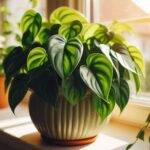The weeping fig, also known as Ficus benjamina, is a popular indoor plant cherished for its graceful, drooping branches adorned with glossy, pointed leaves.

Types of Weeping Fig Plant
Here are some popular cultivated varieties of the Weeping Fig:
- Ficus benjamin
- Ficus benjamina ‘Natascha’
- Ficus benjamina ‘Danielle’
- Ficus benjamina ‘Golden King’
- Ficus benjamina ‘Starlight’
- Ficus benjamina ‘Monique’
Benefits of Weeping Fig Plant
Cleans the Air: Weeping Figs act like natural air purifiers, removing common toxins like formaldehyde and xylene from your home.
Easy on the Eyes: They have beautiful cascading leaves that can add a touch of nature and life to your space.
Low Maintenance: They’re suitable for beginners as they don’t need constant attention. Just water them occasionally and give them some indirect sunlight.
Disadvantages of Weeping Fig Plant
Yes, to put it more simply, these are the negatives of owning a weeping fig plant:
Toxicity to Pets: It’s vital to keep weeping figs away from inquisitive animals as they may be hazardous to pets if swallowed.
Leaf Dropping: Some plant owners find it bothersome when their plants drop leaves since it suggests that they are not content with their environment.
Past Issues: To preserve their health, weeping figs need to be given specific attention as they could attract pests like spider mites and scale insects.
Size Concerns: Due to their large growth potential, they might not be suited for confined locations or persons desiring smaller plants.
Potential Allergy: Some persons may be allergic to the sap or pollen of weeping figs, which can lead to respiratory issues or skin irritation.
Weeping Fig Plant Care
Light: Find a bright spot with indirect sunlight. No harsh afternoon sun!
Water: When the top inch of soil seems dry, water it. Don’t let it sit in water – drainage is key! Water less often in winter.
Humidity: They love moisture! Mist the leaves regularly or use a pebble tray with water.
Location: Pick a spot and stick with it! Weeping Figs don’t like being moved around.
Bonus Tip: Feed your Weeping Fig a balanced houseplant fertilizer once a month during spring and summer.
Propagation of Weeping Fig Plant
Propagating a weeping fig plant can be done through simple methods like stem cuttings:
Select a Stem: Choose a healthy stem from the parent plant. Make sure it’s about 6 inches long and has several leaves.
Prepare the Cutting: Use clean, sharp scissors or pruning shears to cut the stem just below a leaf node (where a leaf meets the stem).
Remove Leaves: With at least two or three leaves remaining at the top, remove the lowest leaves from the cutting. Rooting Hormone (Optional): Dip the cut end of the stem in rooting hormone powder or gel to encourage root growth.
Plant the Cutting: Plant the cutting in a small pot filled with moist, well-draining potting mix. Using a pencil, make a tiny hole in the ground and place the cutting inside.
Provide Humidity: Cover the pot with a plastic bag or place it in a propagation box to create a humid environment.
Place in Indirect Light: Put the pot in a spot with indirect light. Avoid direct sunlight, as it can be too harsh for the young cutting.
Monitor and Water: Keep the soil consistently moist but not waterlogged. Check regularly and water when the top inch of soil feels dry.
Wait for Roots: After a few weeks, the cutting should develop roots. If you gently pull on the stem, you should feel resistance, which indicates the formation of roots.
Transplanting: Once roots have formed, transplant the cutting into a larger pot with regular potting soil. Continue caring for it as you would for a mature weeping fig plant.
Repotting of Weeping Fig Plant
Here’s a simple guide to repotting
Get the fresh pot ready: For drainage, add a layer of crushed terracotta or pebbles. Add a half-fill of new potting mix to the pot.
Take the Weeping Fig out: To dislodge the roots, gently press the pot’s sides. Slid the plant out carefully by tilting the pot.
Examine the roots if you choose to: Use your fingers to gradually loosen the roots if they are tightly around the root ball. Shears can be used to cut off any brown or dead roots.
Place the plant as follows in the new pot: Using the same depth of soil as before, plant the Weeping Fig in the middle of the new container.
Add new potting mix to the pot: After filling up the spaces surrounding the root ball, carefully compact the dirt to eliminate any air pockets. Fill the drainage holes with water and let it run out completely.
Weeping Fig Plant Disease
Maintaining the health of a weeping fig plant requires treating illnesses in it. Here’s a short manual:
Determine the Issue: Keep an eye out for symptoms of illness, such as mold, stains, or yellowing or browning leaves.
Isolate the Plant: To stop the disease from spreading, relocate the afflicted plant away from other plants if you see any symptoms of it.
Modify Care: Verify that the plant is receiving the recommended levels of humidity, light, and water. To establish a healthy atmosphere, modify care as necessary.
Parts Affected by Trim: Using clean, sharp scissors or pruning shears, remove any sick or damaged leaves or branches. To stop the illness from spreading, dispose of the cut portions.
Apply a Fungicide or Pesticide: If the illness doesn’t disappear, you should consider applying a fungicide or pesticide to the plant. Follow the instructions on the product label carefully.
Boost Air Circulation: To avoid moisture accumulation, which can lead to illness, make sure there is adequate air circulation all around the plant.
Steer clear of overwatering: This might result in fungal illnesses and root rot. In between waterings, allow the soil to become somewhat dry.
Observe Frequently: Watch the plant for any indications that the illness is getting better or getting worse. Adapt your care as necessary.
Preserve Cleanliness: To avoid the accumulation of dirt and infections, keep the plant and its surroundings tidy.
The management of plant diseases may need effort and patience. To aid in the plant’s recovery, exercise patience and keep giving it the attention it needs.
Weeping Fig Plant Vastu
Of course! Here’s some basic Vastu placement advice for a weeping fig plant:
Location: Position the weeping fig tree to the northeast or east of your house or place of business. In Vastu, these directions are linked to growth and pleasant energy.
Avoid Placement: According to Vastu principles, avoid placing the plant in the southeast or southwest corners since these directions may produce bad energy.
Maintenance: Water the plant frequently and remove any dead leaves to keep it healthy. A flourishing plant represents good vitality. Choose a pot with a hue that is earthy, blue, or green; they are fortunate according to Vastu.
Steer clear of Thorns: Plants with sharp leaves or thorns should be avoided since they might impede the flow of positive energy.
Cleanliness: To preserve the good energy in the room, keep the area surrounding the plant tidy and clear of debris.
Weeping Fig Plant for Pets
Here’s a quick tip on how to keep your dogs safe near plants that bleed:
Keep Out of Reach: Put the weeping fig plant somewhere your dogs can’t get to, such a high shelf or a room they aren’t allowed in. When your dogs are near the weeping fig, keep a watchful eye on them if they enjoy exploring or chewing on plants. If needed, divert their focus from the plant.
Examine Alternatives: Rather than selecting weeping figs for your garden, think about selecting pet-safe plants if you’re worried about your pets’ safety. There are many non-toxic ways to get some greenery into your house.
Educate: By giving your pets lots of suitable chew toys and rewards and employing positive reinforcement strategies, you may teach them not to chew on plants.
How to Buy Weeping Fig Plant
Purchasing a cheap weeping fig plant may be simple:
Examine Local Stores: Go to any local nurseries, garden centers, or retail establishments such as Home Depot or Walmart. They frequently sell reasonably priced indoor plants, such as weeping figs.
Look Online: Look for sales on weeping fig plants in places such as Amazon or eBay. Sometimes, they may be less expensive than at nearby stores.
Weeping Fig Plant Names in Other Languages
Here are the names of the weeping fig plant in several languages:
- Spanish: Higuera llorona
- French: Figuier pleureur
- German: Trauerfeige
- Italian: Fico piangente
- Portuguese: Figueira-chorona
- Dutch: Treurende vijg
- Russian: Плачущая смоковница (Plachushchaya smokovnitsa)
- Chinese (Mandarin): 垂叶榕 (Chuíyè róng)
- Japanese: ニシキギ (Nishikigi)
- Korean: 울타리고무나무 (Ultarigomunamu)
- Arabic: شجرة التين الباكية (Shajarat alteen albakiyya)
- Hindi: रोने वाला अंजीर पौधा (Rone wala anjeer paudha)
- Bengali: বিলাপ দুর্গন্ধি গাছ (Bilāpa durgandhi gācha)
- Thai: ต้นปาล์มหิน (Ton pāln h̄in)
- Vietnamese: Cây sung rụng lá
- Turkish: Ağlayan incir ağacı
- Greek: Δακρύζον συκιά (Dakrýzon sykiá)
- Swedish: Gråtande fikonträd
- Finnish: Itkevä viikunapuu
- Polish: Płacząca figa
Conclusion
In addition to providing a lovely accent to interior spaces, weeping figs provide several health and wellbeing advantages. It may grow and add happiness to any home or business environment with the right attention and care.
FAQs of Weeping Fig Plant
1. How often should my weeping fig plant be watered?
Ans: When the soil seems dry in the top inch, water your weeping fig. If your finger reaches the dry earth, it’s time to water.
2. Is it okay for my pet to play with the weeping fig plant?
Ans: No, playing with weeping fig plants is not safe for pets. If they consume the plant, it can make them sick.
3. Does sunshine help my weeping fig?
Ans: Weeping figs do want sunshine, but not too much of it. Place it in a well-lit area—avoid direct sunlight, though.
4. My weeping fig’s leaves are dropping off; why is that?
Ans: If you water your plant too little or too much, or if the weather is too hot or too cold, the leaves may fall. Examine your approach to maintaining it.
5. Can I propagate my weeping fig plant further?
Ans: Indeed! You may take cuttings from your weeping fig tree to grow new plants. Simply chop off a tiny bit of branch and submerge it in water to encourage the growth of roots.
6. Is it OK to feed my weeping fig plant?
Ans: Indeed, plants require nourishment just as people do! During the growth season, you may feed it plant food once a month to help it grow robustly.
7. How large can my plant grow a weeping fig?
Ans: If given the chance, weeping figs may get rather large. You can trim them to maintain the desired size, so don’t worry.
8. Can I place my fig plant that weeps outside?
Ans: Although weeping figs are typically indoor plants, you can temporarily move them outside if your environment is warm and windy.
9. How can I maintain the health of my weeping fig plant?
Ans: Ensure that it gets adequate food, drink, and sunlight. Pets shouldn’t chew on it, and it should be kept out of cold drafts.
10. What happens if pests infest my weeping fig tree?
Ans: Inform an adult if you spot any bugs. They can assist you in getting rid of them using non-harmful specialty sprays.






Keep working ,splendid job!